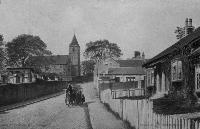Coatbridge & Old Monkland Area
Information specific to this area can be found below and on the left
menu bar. We also recommend consulting the many general pages for
information of general relevance to miners' lives.
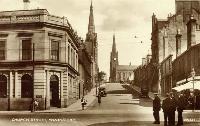 Church St, Coatbridge | |
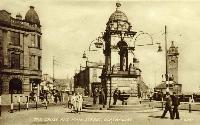 The Cross, Coatbridge | 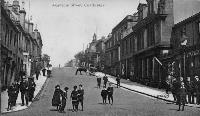 Academy St, Coatbridge |
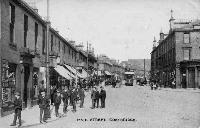 Above: Main St, Coatbridge c1919 | 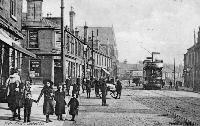 Above: Main St, Coatbridge c1904 |
Below: Views of Summerlee Ironworks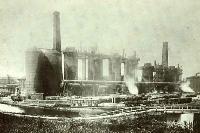 | 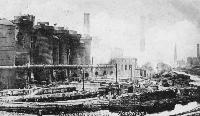 |
See also reports on Mining Districts for descriptions of housing & education in the Coatbridge area
Ordnance Gazetteer of Scotland, Francis H Groome, 1885
Coatbridge, a town of Old Monkland parish, Lanarkshire. It stands at 300 feet above sea level, on the Monkland Canal, and in the midst of a perfect network of railways, being 2 miles W by S of Airdrie, 8 3/4 E of Glasgow, and 34 W by S of Edinburgh. Fifty years since it was only a village and its rapid extension is due to its position in the centre of Scotlands chief mineral field. The Airdrie and Coatbridge district comprises 21 active collieries; and in or about the town are 5 establishments for the pig-iron manufacture-Calder, Carnbroe, Gartsherrie, Langloan, and Summerlee-of whose 41 furnaces 29 were in blast in 1879, when 8 malleable iron-works had 113 puddling furnaces and 19 rolling mills. Nor are these the only industries; boilers, tubes, tinplate, firebrick and fireclay, bricks and tiles, oakum, and railway waggons being also manufactured. Coatbridge, in its growth, has absorbed, or is still absorbing, a number of outlying suburbs-Langloan, Gartsherrie, High Sunnyside, Coats, Clifton, Drumpellier, Dundyvan, Summerlee, Whifflet, Coatdyke, etc.; and the appearance of the whole, redeemed though it is by some good architectural features, is far more curious than pleasing. Fire, smoke, and soot, with the roar and rattle of machinery, are its leading characteristics; the flames of its furnaces cast on the midnight sky a glow as if of some vast conflagration. Wholly almost of recent erection, it has stations on the Caledonian and North British railways, a post office, with money order, savings' bank, insurance, and railway telegraph departments, branches of the Clydesdale, National, Royal, and Union banks, 24 insurance agencies, 2 hotels, a literary association, gas-works, a water company conjointly with Airdrie, and a Saturday paper, the Airdrie and Coatbridge Advertiser (1855). A theatre and music hall, seating 2000 spectators, was opened in 1875; and at Langloan is the West End Park, where in 1880 a red granite fountain, 20 feet high, was erected in memory of Janet Hamilton (17951873), the lowly Coatbridge poetess. Gartsherrie quoad sacra church (1839; 1050 sittings) cost over £3300, and is a prominent object, with a spire 136 feet high; and Coats quoad sacra church (1875; 1000 sittings) is a handsome Gothic edifice, built from endowment by the late George Baird of Stitchell. Of 4 Free churches-Middle, East, West, and Whifflet-the finest was built in 1875; and other places of worship are a U.P. church (1872), a Congregational church, an Evangelical Union church, a Baptist church, a Wesleyan church (1874), St John's Episcopal church (1843-71), and two Roman Catholic churches, St Patrick's (1848) and St Mary's, Whifflet (1874). Besides other schools noticed under Old Monkland, Coatbridge public school, Langloan public school, and St Patrick's Roman Catholic school, with respective accommodation for 795,388, and 582 children, had (1880) an average attendance of 751,373, and 456, and grants of 739,10s., £282,14s. 2d., and £347,7s. Pop. (1831) 741, (1841) 1599, (1851) 8564, (1861) 12,006, (1871) 15,802, (1881) 18,425, or, with Whifflet, 20,608.
Baillieston, a large mining village and a quoad sacra parish, in the civil parish of Old Monkland, Lanarkshire, with a station on the Rutherglen-Coatbridge branch of the Caledonian, 3 1/2 miles W by S of Coatbridge, and 6 1/2 miles E of Glasgow. The village is lighted with gas, has a post office under Glasgow, and a railway telegraph office, and contains an Established, a Free, and a U.P. church, besides St John's Episcopal and St Bridget's Roman Catholic churches. Under Old Monkland school-board there are a Sessional and a Roman Catholic school, which, with respective accommodation for 215 and 143 children, had an average attendance (1879) of 209 and 149, and grants of £213, 8s. 6d. and £127, 11s. The Baillieston and Shettleston mining district included in that year 22 active collieries, 16 of them at Baillieston itself. Pop. of village (1861) 1832, (1871) 2805, (1881) 2990; of q. s. parish (1871) 4924, (1881) 3477.
Bargeddie, a post office village in Old Monkland parish, Lanarkshire, 1 3/4 mile WSW of its post-town, Coatbridge. Here in the autumn of 1876 a church was opened for the quoad sacra parish of Bargeddie, which, formed in 1875, is in the presbytery of Hamilton and synod of Glasgow and Ayr. Geometrical Gothic in style, this church consists of an aisled nave, semi-octagonal transepts, and an apse, with a spire 130 feet high, stained-glass windows, etc. A sessional school, with accommodation for 220 children, had (1879) a day and an evening attendance of 235 and 49, and grants of £223, 8s. And £28, 6s. Pop. of village (1881) 100; of q. s. parish (1881) 2980.
Braehead, a village near Baillieston, Old Monkland parish, Lanarkshire, 2 miles W of Coatbridge.
Broomhouse, a village on the W border of Old Monkland parish, Lanarkshire, near Tollcross.
Calder, a seat of iron-works in Old Monkland parish, Lanarkshire, on North Calder river, adjacent to Carnbroe village in Bothwell parish, 1 1/2 mile NNE of Holytown, and 2 miles SSE of Airdrie. The iron-works were founded in 1805; adopted the hot blast immediately after its invention in 1824; had 4 furnaces, and manufactured annually about 12,000 tons of iron in 1835; and had 6 furnaces built, and 4 in blast in 1879. They adopted the newly patented Ferrie furnace system in the latter part of 1870, the effect of which is to save 4s. 6d. in coal, 2s. 5d. in ore, and 3s. 3d. in dross on every ton of coal, equal on a production of 10,000 tons to £5083, 6s. 8d. The works have always been supplied with ironstone from New Monkland parish, and receive the output of two ironstone pits, 36 fathoms deep, on Garturk estate. Two coalpits are near, respectively 40 and 100 fathoms deep, the latter being the deepest pit in the parish. A board school here, with accommodation for 227 children, had (1879) a day and an evening attendance of 220 and 42, and grants of £188, 2s. And £22, 0s. 6d. Calder proper and Carnbroe are jointly called Calder Iron-works. Pop. of the whole (1861) 2136, (1871) 1787, (1881) 1895.
Calderbank, a large industrial village of NE Lanarkshire, partly in Bothwell but chiefly in Old Monkland parish, on the North Calder Water, 2 miles SSE of Airdrie. It has a post office under Airdrie, a board school, and an Established chapel of ease; and at it are situated the iron-works of the Monkland Company, with 6 blast furnaces, 46 puddling furnaces, and 6 rolling mills. The school, with accommodation for 252 children, had (1879) an average attendance of 186, and a grant of £158, 9s. Pop. (1841) 1064, (1861) 2461, (1871) 2176, (1881) 1739.
Carmyle (Gael. cathair-maol, 'bare town'), a village on the SW border of Old Monkland parish, Lanarkshire, on the right bank of the Clyde, adjacent to the Rutherglen, Baillieston, and Coatbridge branch of the Caledonian railway, 1 1/2 mile NNE of Cambuslang, and 4 1/2 miles SSE of Glasgow. Occupying a beautiful site, amid charming environs, it originated in a muslin manufactory, erected about 1741; it presents a straggling rural appearance, with intermixture of garden-plots and trees; and it has a station on the railway, and old-fashioned meal-mills, with foaming dams. Pop. (1841) 238, (1861) 506, (1871) 462, (1881) 536.
Carnbroe, an estate, with a mansion, and a village on the N border of Bothwell parish, Lanarkshire. The mansion stands on North Calder Water, near the Caledonian railway, 1 1/4mile NNE of Bellshill. The estate is rich in coal and ironstone, and has within it collieries and iron-works. The village adjoins Calder in Old Monkland parish, and forms part of Calder Iron-works. Pop. (1861) 904, (1871) 873, (1881) 739.
Clifton, the seat of malleable iron works in Old Monkland parish, Lanarkshire, in the vicinity of Coatbridge. In 1879 it had 19 puddling furnaces and 3 rolling mills.
Clyde Iron-works, a village, with large pig-iron works, in the SW corner of Old Monkland parish, Lanarkshire, on the right-bank of the Clyde, in the southern vicinity of Tollcross, 3 miles ESE of Glasgow. The works employ the most improved methods of smelting; draw their supplies of blackband ironstone from Old and New Monkland and parishes; and had 6 furnaces built and 4 in blast in 1879.
Coats, a quoad sacra parish formed in 1874 from the civil parish of Old Monkland, Lanarkshire, and including part of the town of Coatbridge. It is in the presbytery of Hamilton and synod of Glasgow and Ayr. Pop. (1881) 3928.
Coatdyke, a village chiefly in Old Monkland, but partly also in New Monkland parish, Lanarkshire, 1 mile WSW of Airdrie, and 1 E of Coatbridge, under which it has a post office, with money order and savings' bank departments. A U.P. mission station was opened here in 1881. Pop. (1881) 2406.
Crosshill, a south-eastern outbreak of Baillieston village, in Old Monkland parish, Lanarkshire.
Drumpellier, extensive iron-works and mineral pits of Old Monkland parish, Lanarkshire, in the western vicinity of Coatbridge. Drumpellier House, 1 1/4mile W of the town, is the property of D. Carrick-Buchanan, Esq. of Carradale, who holds 868 acres in Lanarkshire, valued at £500 per annum.
Dykehead, a village in Old Monkland parish, Lanarkshire, 1 1/4 mile E of Baillieston.
Faskine, an estate and a village in Old Monkland parish, Lanarkshire, on the right bank of North Calder Water, 3/4 mile W of Calderbank. The estate contains coal and ironstone mines, worked from an earlier period than any others in the great Clydesdale mineral field. Pop. (1861) 514, (1871) 656, (1881) 475.
Greenend, a village in Old Monkland parish, Lanarkshire, 1 1/2 mile ESE of Coatbridge.
Kirkwood or Braehead, a collier village in Old Monkland parish, Lanarkshire, 2 miles SW of Coatbridge. Pop. (1871) 491, (1881) 667.
Muirhead, a village in Old Monkland parish, Lanarkshire, close to Baillieston station.
West Merryston, a village in Old Monkland parish, Lanarkshire, close to Easterhouse station, and 3 1/4 miles W of Coatbridge. Pop. (1861) 627, (1871) 541, (1881) 534.
A topographical dictionary of Scotland, Samuel Lewis, 1846
Baillieston, a village, in the late quoad sacra parish of Crosshill, parish of Old Monkland, Middle ward of the county of Lanark, 4 3/4 miles (E by S) from Glasgow; containing 639 inhabitants. This is the principal village of Crosshill parish, and is situated in the western part of the parish of Old Monkland, on the border of that of Barony, and near the roads from Glasgow to Airdrie and to Hamilton. For many years past, the Monkland, Bothwell, Barony, and Cadder Farming Society have held their annual exhibition of live stock in the village, and it is considered in Scotland as being second only to the exhibitions of the Highland Society; the description of stock is of the first class, and prizes are frequently obtained by agriculturists of this neighbourhood, at the latter exhibitions, where the competition is open to England and Scotland. A subscription library is supported here.
Barachnie, a village, in the parish of Old Monkland, forming part of the late quoad sacra parish of Crosshill, Middle ward of the county of Lanark, 3 1/2 miles (E.) from Glasgow; containing 235 inhabitants. This place is situated on the road from Glasgow to Airdrie, a short distance from Bailiestone Toll, and on the borders of Barony parish. In the vicinity are extensive coal-works.
Craigend, a village, in the late quoad sacra parish of Crosshill, parish of Old Monkland, Middle ward of the county Lanark, 4 1/2 miles (E. S. E.) from Glasgow; containing 80 inhabitants. It is situated on the bank of the river Clyde, which here makes a considerable bend, and on the road from Glasgow to Bellshill, in the parish of Bothwell.
Crosshill, lately a quoad sacra parish, in the parish of Old Monkland, Middle ward of the county of Lanark, 4 1/2 miles (E by S) from Glasgow; containing, with the villages of Baillieston, Barachnie, Craigend, West Merrystone, and Swinton, 2591 inhabitants. This district is, for the most part, beautifully situated, the land rising considerably above the vale of the Clyde, and commanding, on the south, an interesting view of all the hills and heights from the western shore to the ridge of Tinto on the east, and on the north from Ben Lomond all along the Campsie and Kilsyth hills. It is about eighteen square miles in extent, the whole under cultivation, with the exception of a few acres of plantation. The soil is chiefly sandy, but towards the north of a stiff clayey nature, and the farms have been latterly very much improved by tile-draining: the average rent is now about £2 5s per acre. The freestone and coal formations prevail, and there are seven coal-mines, of which six are at present in operation. The road between Glasgow and Edinburgh, and the Monkland canal, pass through the parish, the latter affording great facilities for the conveyance of coal to Glasgow, and of manure and other heavy articles to the farmers along the whole of its line, on which are also boats for passengers. Among the chief mansions are Mount Vernon, Blairtummock, Easterhouse, Baillieston House, and Garrowhill, the last the residence for some time of a former Duchess of Atholl. The ecclesiastical affairs are under the presbytery of Hamilton and synod of Glasgow and Ayr: the church was erected in 1833, by subscriptions from the neighbouring heritors, aided by £50 from the university of Glasgow, and is a neat plain edifice, with a belfry, and contains 494 sittings, of which twenty-six are free. The stipend of the minister is £70, raised by seat-rents; patrons, the Subscribers and Pew-holders. The United Secession had a place of worship here for several years, but it has been converted into dwelling-houses. There are schools connected with some of the coal-works; and of two other schools, one is aided by the heritors of Old Monkland and the congregation of Crosshill, and the master of the other has a free house, school-house, and garden.
Coatbridge, a village, in the late quoad sacra parish of Gartsherrie, parish of Old Monkland, Middle ward of county Lanark, l 1/2 mile (NW) from Airdrie, containing 1599 inhabitants. This is a very thriving place, which has more than doubled in extent and population within the last fifteen years, owing to the extension of the iron trade in the district, and to its being in the vicinity of valuable coal-mines; the Dundyvan and Summerlee iron-works in the neighbourhood are conducted on a large scale, and afford employment to a great part of the population. The village is on the road from Airdrie to Glasgow; and the Monkland canal also affords facilities of communication with the adjacent towns. A post-office has been established here, and there is a place of worship for members of the Free Church.
Coatdyke, a village, in the late quoad sacra parish of Gartsherrie, parish of Old Monkland, Middle ward of county Lanark; containing 459 inhabitants. This place participates largely in raising the mineral products of the district, iron and coal; and in the neighbourhood are several quarries, including one of white freestone, of which the thickness is, in some parts, seventy feet.
Dundyvan and New Dundyvan, villages, in the parish of Old Monkland, Middle ward of the county of Lanark, 1 1/2 mile (W. S. W.) from Airdrie; containing, the one 1298, and the other 2202 inhabitants. These are two among numerous villages which have lately and rapidly sprung up in connexion with the extensive coal mines and iron and other works of this district, so distinguished for its mineral wealth and manufacturing importance. They lie on the high road from Airdrie to Glasgow, and are the seats of considerable iron establishments, which employ nearly the whole of the male population. The ironstone wrought at the furnaces here, of which there are several, is of the most valuable kind, some of it yielding from thirty to forty per cent of iron, and is usually denominated the " black band,'' and chiefly produced from the lands of Rochsilloch, the property of Sir William Alexander. About a mile south-east of Dundyvan are the celebrated Calder iron-works, and at the same distance westward are the Drumpellier coal mines; and all around, pits and quarries are in full operation.
Gartcloss, a village, in that part of the parish of Old Monkland which formed the late quoad sacra parish of Gartsherrie, Middle ward of the county of Lanark, 2 miles (N. W.) from Coatbridge; containing 206 inhabitants. It lies in the north-eastern part of the parish, near the border of Cadder parish, and in the neighbourhood of the Gartcloss coal-mine, one of the most considerable in the district : the inhabitants are chiefly employed in this mine.
Gartsherrie, lately a quoad sacra parish, in the parish of Old Monkland, county of Lanark ; containing, with the villages of Coatbridge, Coatdyke, Gartcloss, Merrystone, and Summerlee, 5906 inhabitants, of whom 1499 are in the village of Gartsherrie, 2 miles (W.) from Airdrie. This is a considerable mining district, in the works connected with which the chief of the population are employed: the ironworks are of great magnitude, and include a number of blast-furnaces for the smelting of the ore. The coal-mine here is also worked on a very extensive scale; there are five strata of coal, between each of which is a stratum of sandstone and shale : the seams of coal vary in thickness from one foot four inches to four feet. The Glasgow and Garnkirk railway, which starts from St. Rollox, in the north-east quarter of the city, joins the Monkland and Kirkintilloch railway at this place. The ecclesiastical affairs are under the presbytery of Hamilton and synod of Glasgow and. Ayr, and the patronage is vested in the subscribers to the church; the stipend of the minister is £150, secured by bond. The church, erected at a cost of £3300, is an elegant structure, with a tower rising to the height of 136 feet, and contains 1500 sittings. Near it is the Academy, erected in 1844, at cost of £2300 ; and there is a large Sabbath school in connexion with the Establishment.
Langloan, a village, in the parish of Old Monkland, Middle ward of the county of Lanark, 2 1/2 miles (W. by S.) from Airdrie; containing 1111 inhabitants. This is one of the principal villages of the many in this great mining and manufacturing parish : it is situated on the road from Airdrie to Glasgow, and has of late years increased exceedingly in extent and population. In the vicinity is a considerable red-sandstone quarry.
Merryston, a village, in the parish of Old Monkland, forming part of the late quoad sacra parish of Gartsherrie, Middle ward of the county of Lanark, 2 1/2 miles (W. by S.) from Airdrie ; containing 676 inhabitants. It is situated a short distance north of the high road from Airdrie to Glasgow, and on the banks of the Monkland canal ; and is one of the numerous villages whose increasing population is engaged in the mines and manufactures of this rich mineral district.
Merryston, West, a village, in the parish of Old Monkland, forming part of the late quoad sacra parish of Crosshill, Middle ward of the county of Lanark, 1 1/4 mile (N. E.) from Baillieston ; containing 493 inhabitants. This village, called also Marystown, is, like the preceding, situated on the banks of the Monkland canal, and owes its late increase in extent, and in the number of its inhabitants, to the flourishing condition of the mines and manufactures in its vicinity.
Summerlee, a village, in the parish of Old Monkland, forming part of the late quoad sacra parish of Gartsherrie, Middle ward of the county of Lanark, 2 miles (W. N. W.) from Airdrie; containing 625 inhabitants. This village is situated in the eastern part of the parish, in a district abounding in coal and ironstone ; and is the seat of several blast-furnaces and of iron-works, in which the population is almost exclusively employed. The Messrs. Wilson and Company are the proprietors of the great iron-works here ; and this village and Gartsherrie are the only places of the many in the parish wherein similar works are carried on, in which the furnaces are not in operation on the Sabbath-day. A great quantity of the Rochsilloch ironstone, so well known for its excellence, is wrought by the Summerlee Company ; and a white freestone is quarried in the neighbourhood, chiefly for their use.
Swinton a village, in the parish of Old Monkland, forming part of the late quoad sacra parish of Crosshill, Middle ward of the county of Lanark, 3 miles (W. by N.) from Old Monkland village ; containing 184 inhabitants. It lies in the north-western part of the parish, a little south of the Monkland canal, and about half a mile to the north of Crosshill.
